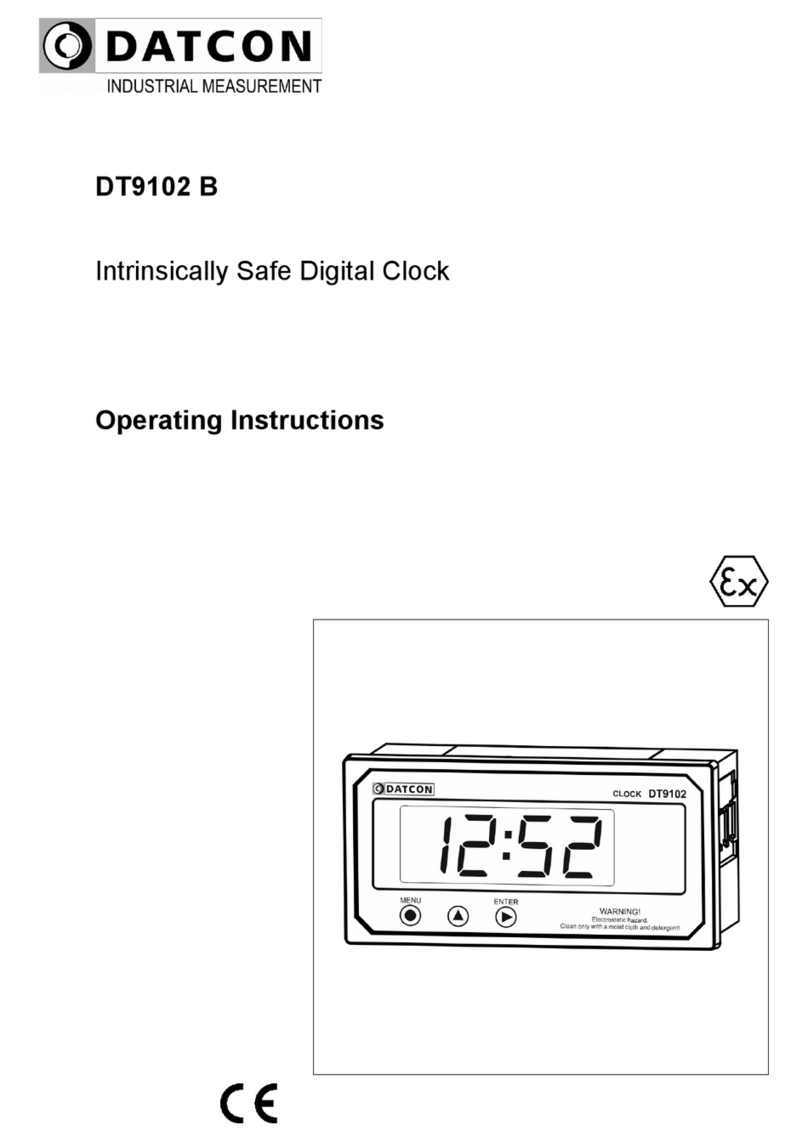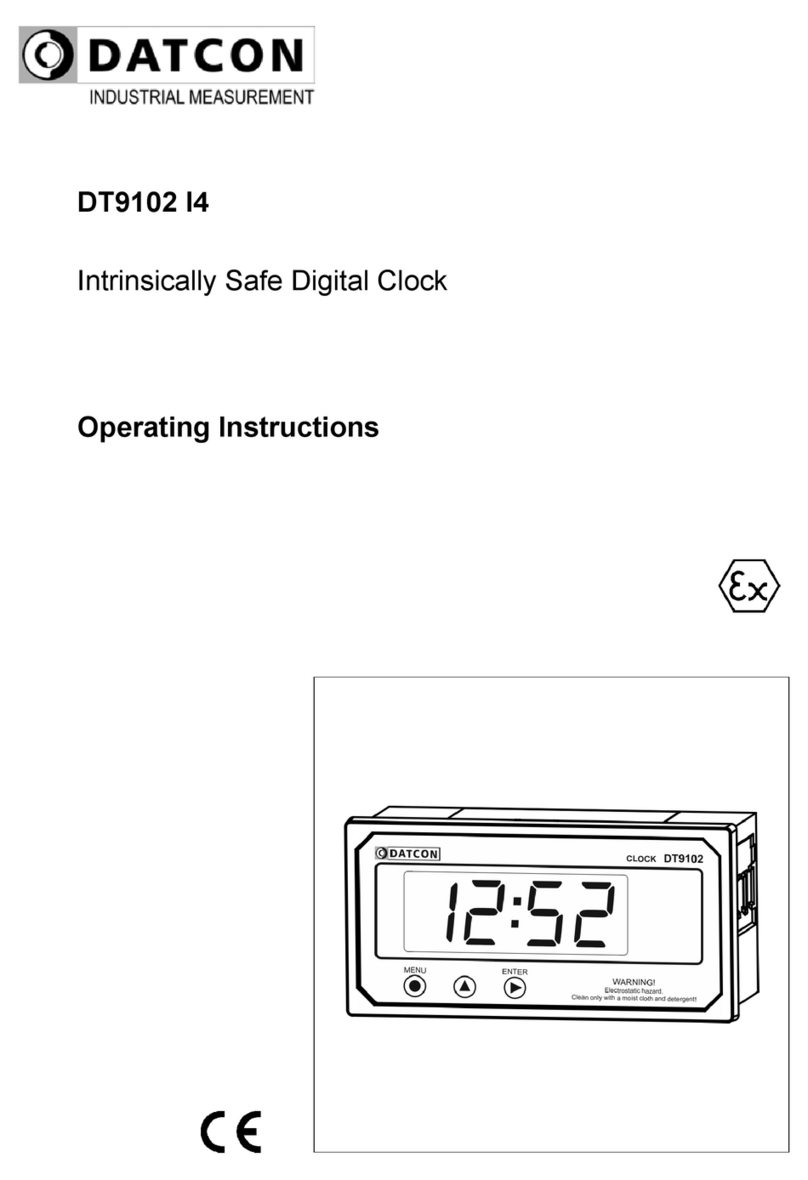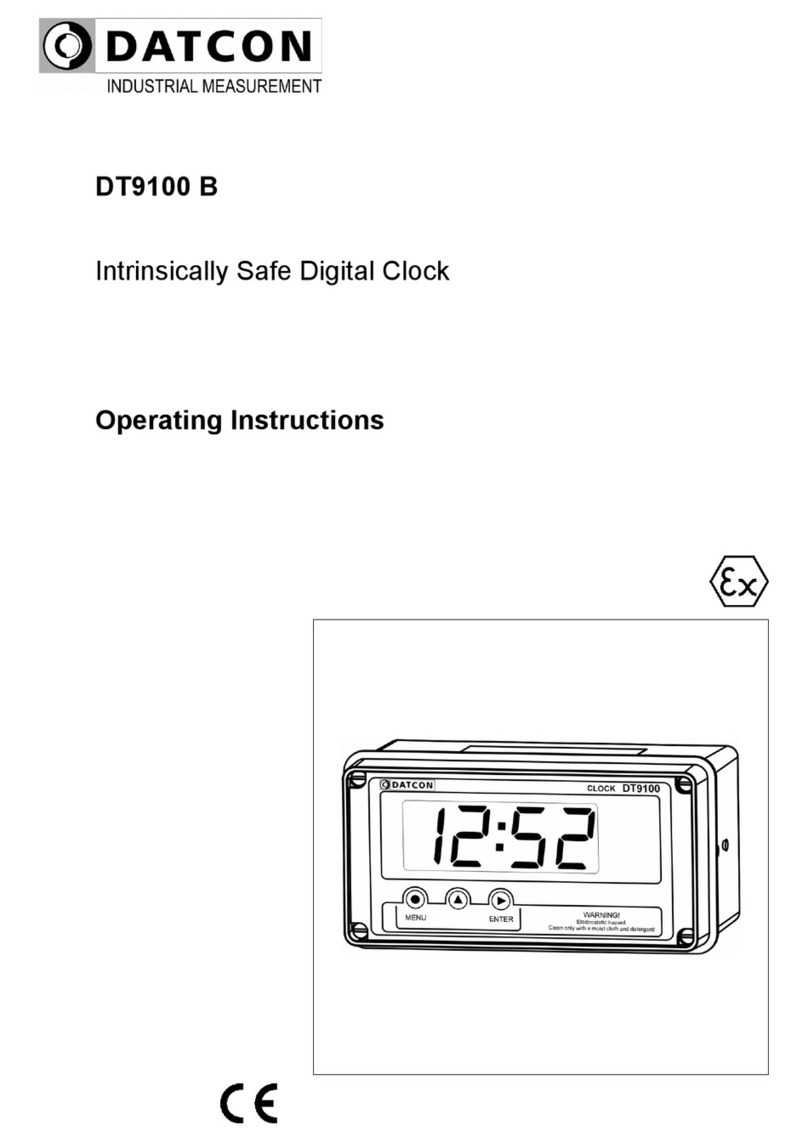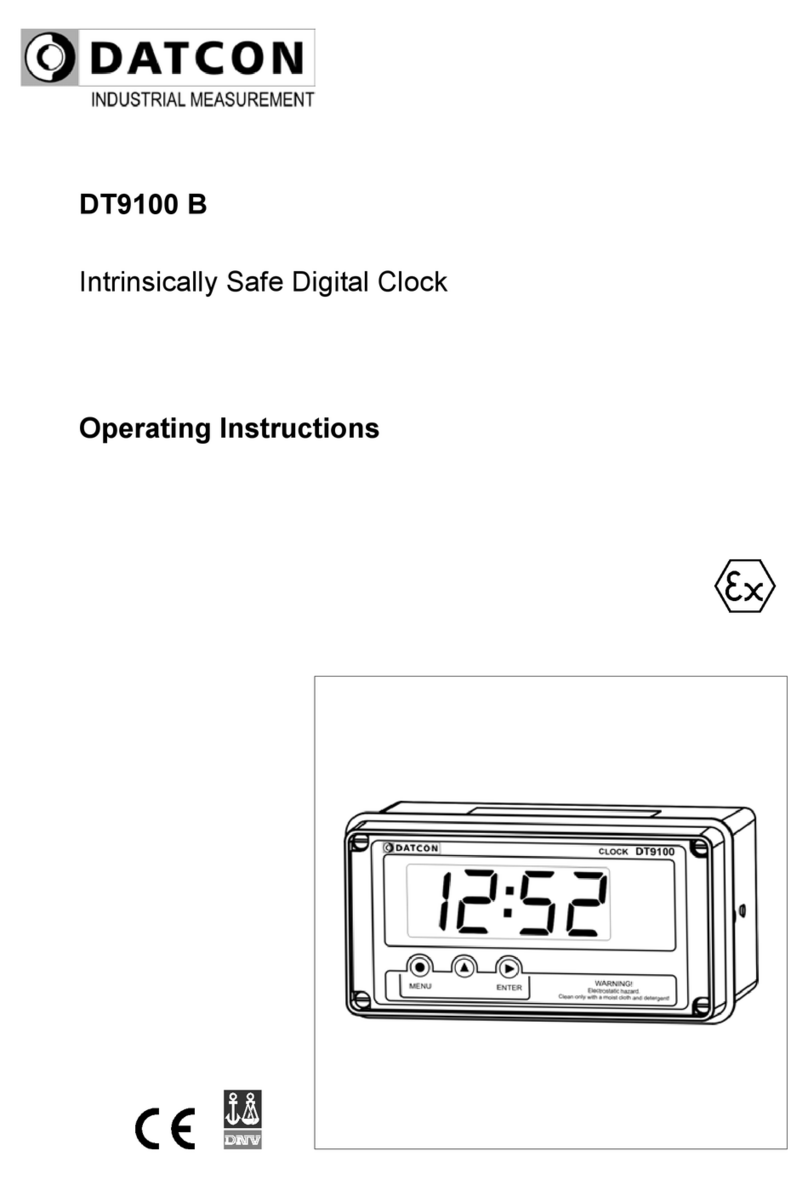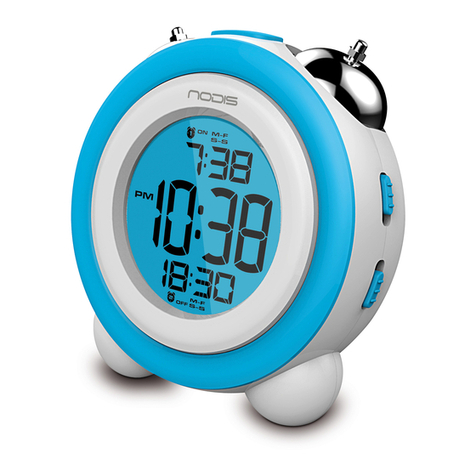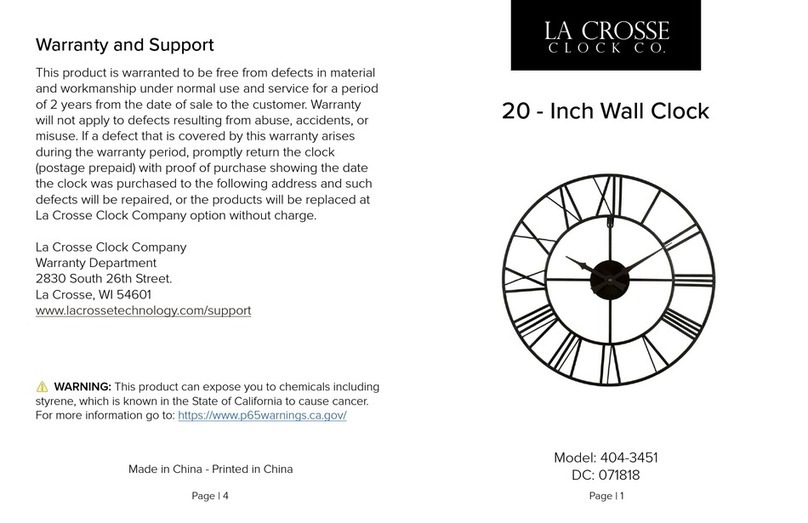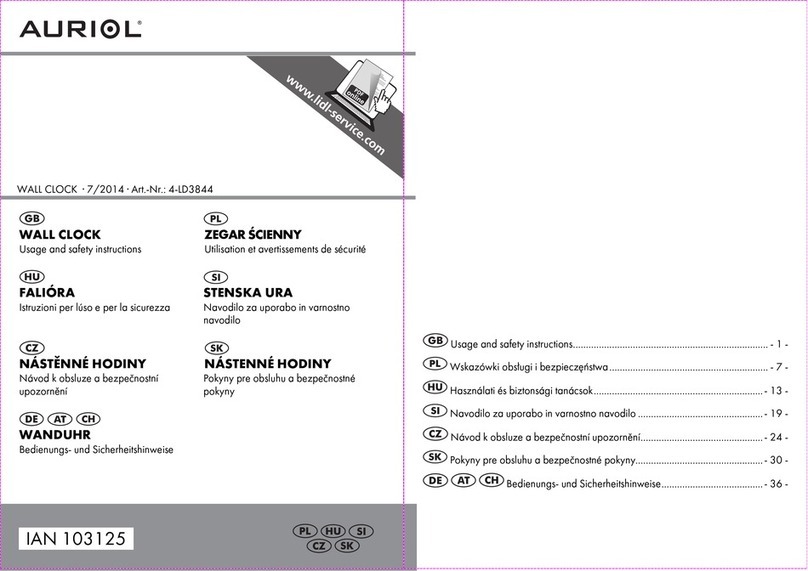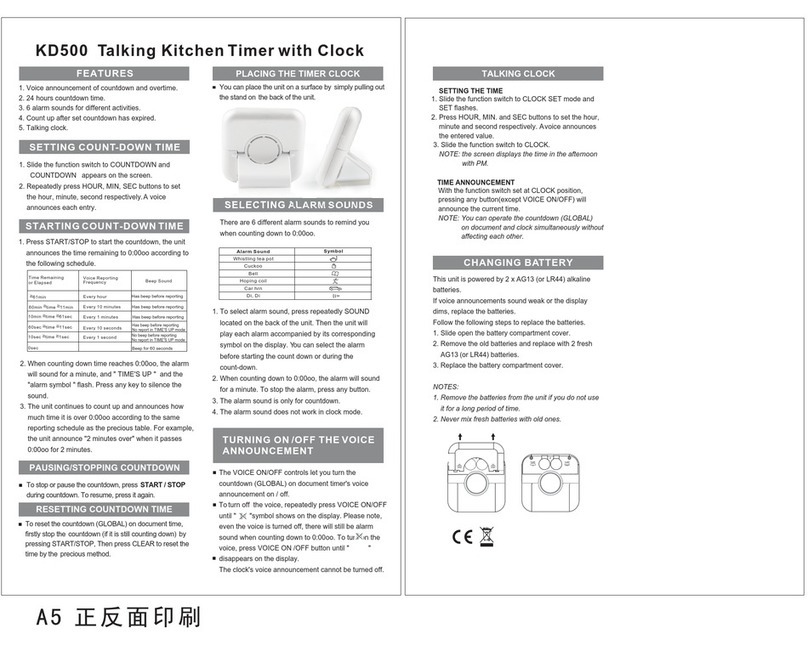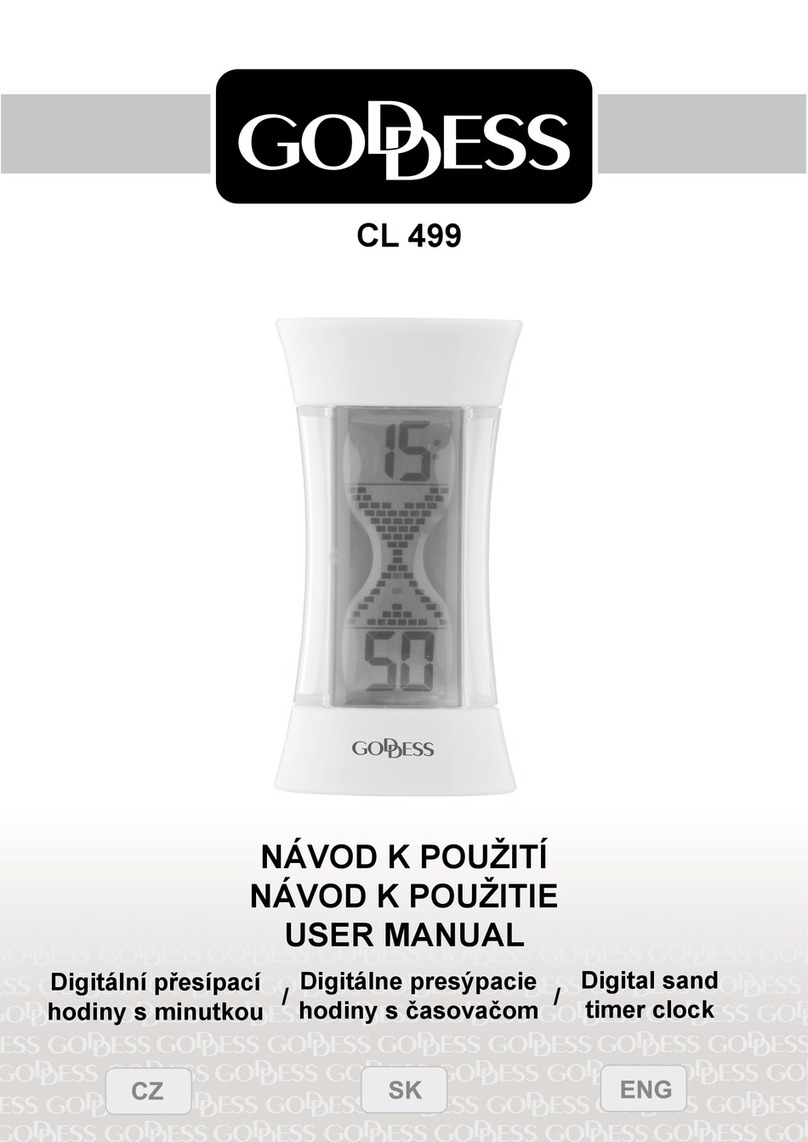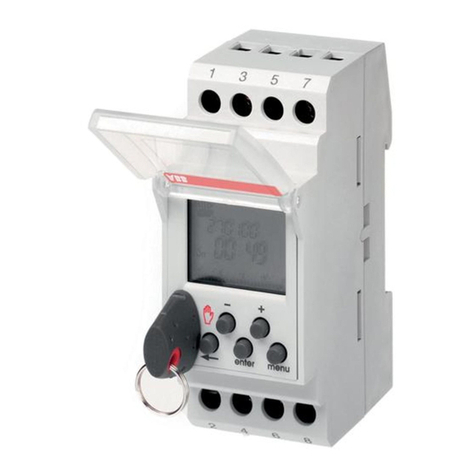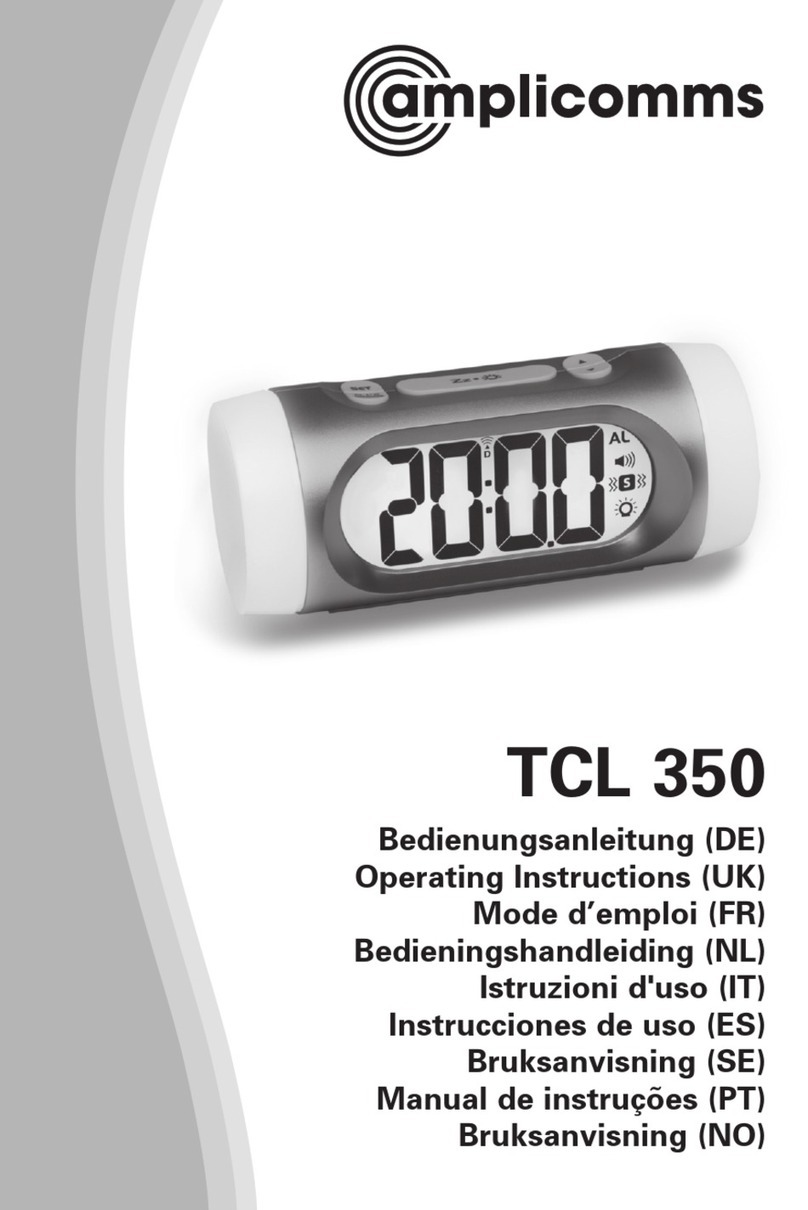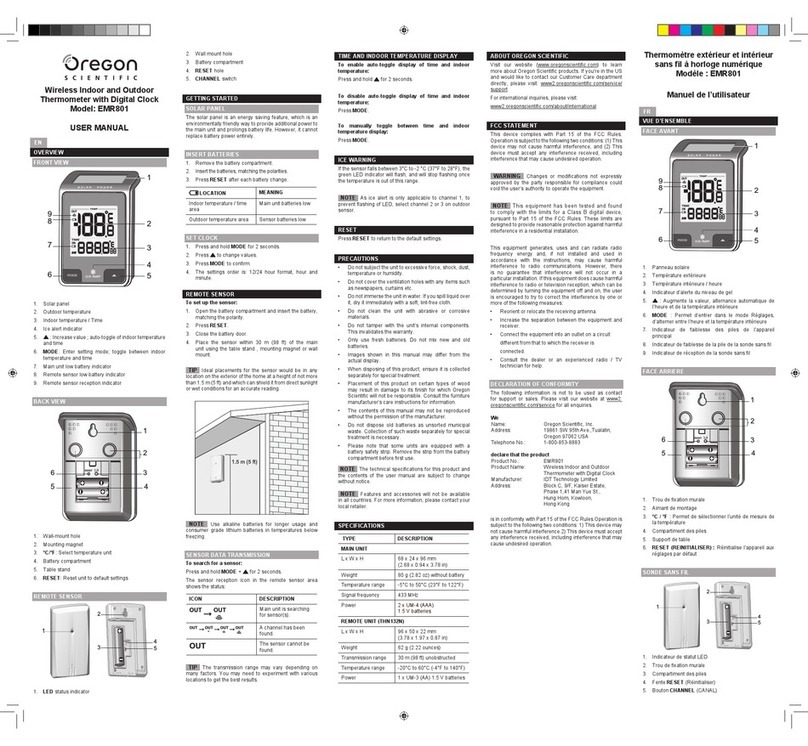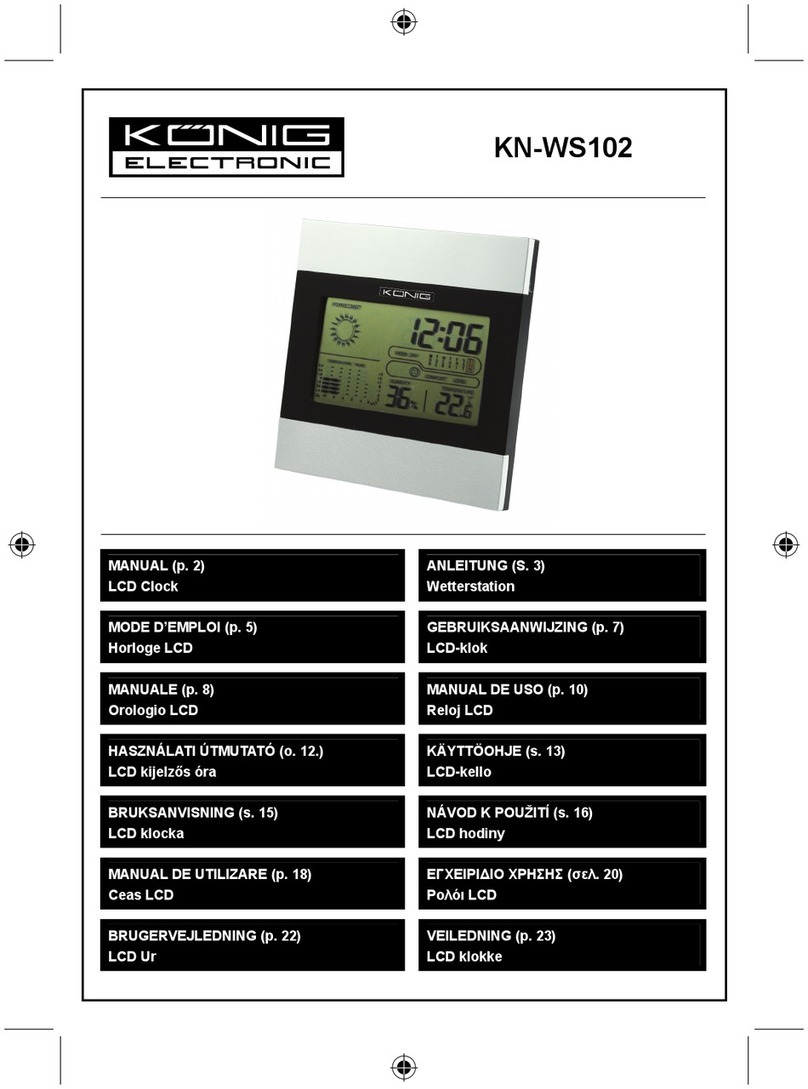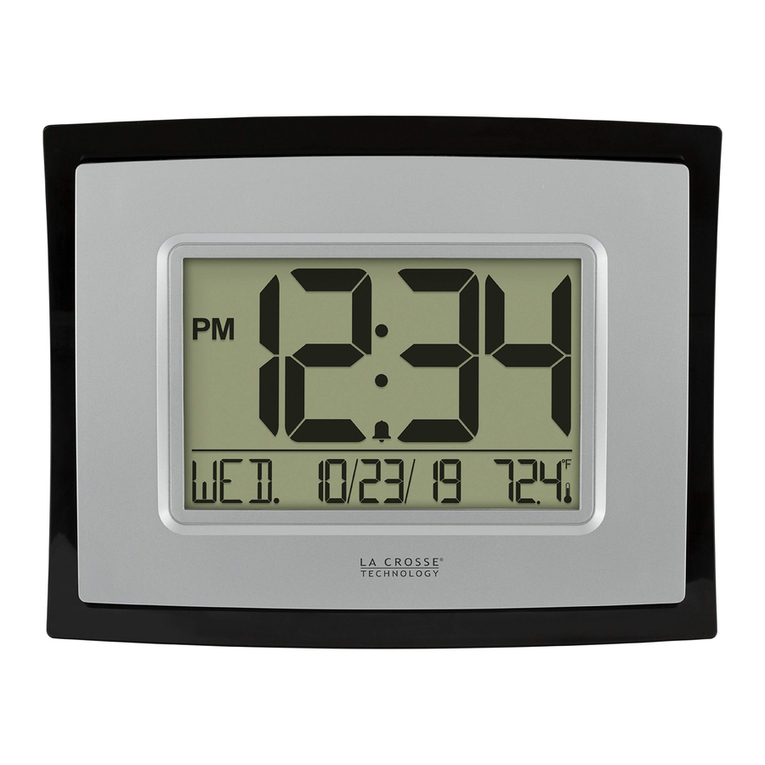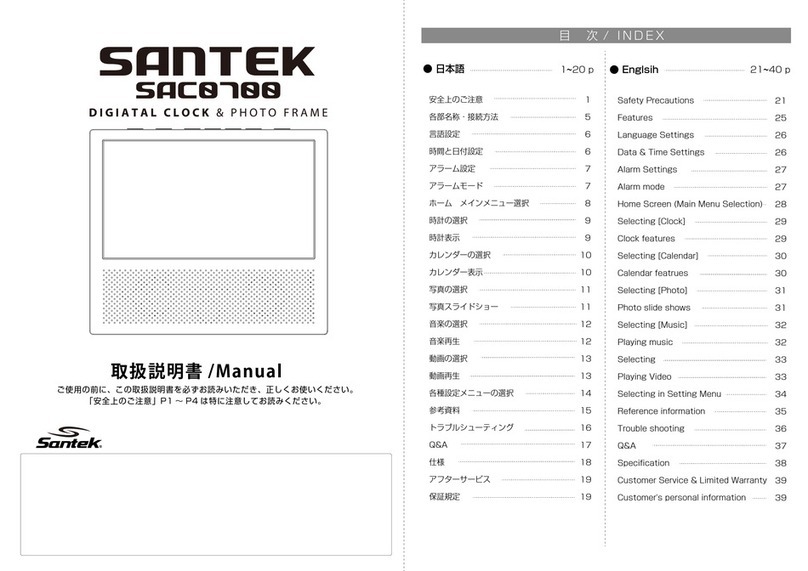Datcon DT9100 I4 User manual

DT9100 I4
Intrinsically Safe Digital Clock
Operating Instructions

DT9100 I4
Contents
1. About this document.....................................................4
1.1. Function.....................................................................................4
1.2. Target group..............................................................................4
1.3. Sym olism used........................................................................4
2. For your sa ety..............................................................5
2.1. Authorised personnel.................................................................5
2.2. Appropriate use.........................................................................5
2.3. Warning a out misuse...............................................................5
2.4. General safety instructions........................................................5
2.5. CE conformity............................................................................5
2.6. Safety information for Ex areas.................................................6
2.7. Environmental instructions........................................................6
3. Product description.......................................................7
3.1. Delivery configuration................................................................7
3.2. Principle of operation.................................................................8
3.3. Adjustment.................................................................................9
3.4. Storage and transport................................................................9
4. Mounting......................................................................10
4.1. General instructions.................................................................10
4.2. Main dimensions of the instrument..........................................11
4.3. Mounting as a wall-instrument.................................................12
4.4. Mounting as a panel-instrument..............................................15
5. Connecting...................................................................17
5.1. Preparing the connection.........................................................17
5.2. Connecting the digital outputs.................................................20
5.3. Connecting into the current loop (synchronising input)...........21
6. Display and manual controls......................................24
6.1. The first start-up.......................................................................24
6.2. Characters and mnemonics appearing on the display............25
6.3. Manual controls.......................................................................27
220180905-V120180905-V1

DT9100 I4
7. Setting up.....................................................................28
7.1. Type in the code (password)...................................................28
7.2. The menu.................................................................................29
7.3. Second clear (01. menu item).................................................30
7.4. Time-set (02. menu item)........................................................31
7.5. User code (03. menu item)......................................................32
7.6. Synchronisation mode (04. menu item)..................................34
7.7. Synchronisation time (05. menu item).....................................35
7.8. Synchronisation gate time (06. menu item).............................36
7.9. Digital output 1 (07. menu item)..............................................37
7.10. Digital output 2 (08. menu item)............................................38
7.11. Changing the supervisor code (09. menu item)....................39
7.12. Tests (10. menu item)............................................................41
8. Fault recti ication.........................................................43
8.1. Fault finding.............................................................................43
8.2. Repairing..................................................................................43
9. Dismounting................................................................43
9.1. Dismounting procedure...........................................................43
9.2. Disposal...................................................................................43
10. Appendix....................................................................44
10.1. Technical specifications.........................................................44
10.2. Application example..............................................................46
10.3. Error messages.....................................................................47
10.4. Messages of critical errors.....................................................48
10.5. Description of the menu items...............................................49
10.6. Messages and error messages during setting up.................52
10.7. Setting the time (example)....................................................53
10.8. ATEX Certification.................................................................55
20180905-V1 3

DT9100 I4
1. About this document
1.1. Function
This operating instructions manual has all the information
you need for quick set-up and safe operation of DT9100 I4.
Please read this manual efore you start setup.
1.2. Target group
This operating instructions manual is directed to trained
personnel. The contents of this manual should e made
availa le to these personnel and put into practice y them.
1.3. Symbolism used
In ormation, tip, note
This sym ol indicates helpful additional information.
Caution, warning, danger
This sym ol informs you of a dangerous situation that could
occur. Ignoring this cautionary note can impair the person
and/or the instrument.
Ex applications
This sym ol indicates special instructions for Ex
applications.
•
List
The dot set in front indicates a list with no implied
sequence.
→
Action
This arrow indicates a single action.
1
Sequence
Num ers set in front indicate successive steps in a
procedure.
420180905-V120180905-V1

DT9100 I4
2. For your sa ety
2.1. Authorised personnel
All operations descri ed in this operating instructions
manual must e carried out only y trained and authorised
specialist personnel. For safety and warranty reasons, any
internal work on the instruments must e carried out only y
DATCON personnel.
2.2. Appropriate use
The DT9100 I4 is a 4–20mA loop-powered intrinsically safe
digital clock. Detailed information on the application range
of the DT9100 I4 is availa le in chapter „Product
description”.
2.3. Warning about misuse
Inappropriate or incorrect use of the instrument can give
rise to application-specific hazards, or demage to system
components through incorrect mounting or adjustment.
2.4. General sa ety instructions
The DT9100 I4 is a high-tech instrument requiring the strict
o servance of standard regulations and guidelines. The
user must take note of the safety instructions in this
operating instructions manual, the country-specific
installation standard as well as all prevailing safety
regulations and accident prevention rules.
2.5. CE con ormity
The DT9100 I4 is in conformity with the provisions of the
following standards:
MSZ EN 60079-0:2013 (ATEX)
MSZ EN 60079-11:2012 (ATEX)
MSZ EN 61326-1:2013 (EMC)
20180905-V1 5

DT9100 I4
2.6. Sa ety in ormation or Ex areas
Please note the Ex-specific safety information for
installation and operation in Ex areas. These safety
instructions are part of the operating instructions manual
and come with the Ex-approved instruments.
2.7. Environmental instructions
Protection of the environment is one of our most important
duties.
Please take note of the instructions written in the following
chapters:
• Chapter 3.4. Storage and transport
• Chapter 9.2. Disposal
620180905-V120180905-V1

DT9100 I4
3. Product description
3.1. Delivery con iguration
Delivered items The scope of delivery encompasses:
• DT9100 I4 digital clock
• 2 pcs. of srew clamps (only panel mounting version)
• 1 pcs. M16x1.5 ca le entries
• instrument sealing (only panel mounting version)
• documentation:
this oparating instructions manual
certification
warranty
The instrument is uilt from the following main parts:
Main parts
1. instrument case
2. front panel with 3 mem rane push uttons
20180905-V1 7

DT9100 I4
3.2. Principle o operation
Area o application DT9100 I4 is an intrinsically safe digital clock ena le
accurate time to e displayed in even the most hazardous
plant areas: Zone 1, 2 or in the safe area.
Synchronising function allows the clock to e synchronised
with a master clock. The clock can e synchronise through
the current loop. When the loop current is over 12 mA the
clock stop going when the loop current decrease under
8 mA the clock will re-start from a new time selected in the
programme menu. This may e the nearest minute or the
nearest hour of the original display or a preset time may e
entered during programming.
The DT9100 I4 has two isolated digital outputs, which can
e used for alarm signaling or for synchronising other
clocks.
DT9100 I4 is housed in a moulded polycar onate case
hauseproof to IP65 for installation in the field or on the
control panel.
Operating principle The clock incorporate a high accuracy temperature
compensated time ase, which is processed y a
microcontroller. The microcontroller produces the real time,
in 24 hour HH:MM format, drives the large 4 digit 25,4 mm
height LCD display, process the front panel keypad, the
synchronising inputs, and drives the digital outputs. The
settings and the actual time are stored in a memory which
stores it’s content for cca. 1 hour for ridging the supply
current failure. The clock also going for cca. 1 hour at this
case.
Power supply DT9100 I4 is loop-powered from 4–20 mA synchronising
signal, dropping less than 2,2 V.
It is not recommended to ring the supply current elow
8 mA.
820180905-V120180905-V1

DT9100 I4
3.3. Adjustment
The DT9100 I4 can e adjusted through the 3 front panel
mem rane keypad. The instrument doesn’t need any
internal adjustment.
All settings are stored in a attery ack-up RAM.
At first installation you have to set the time and other
working parameters what you need.
At attery replacement the settings are kept for min. 1 hour.
3.4. Storage and transport
This instrument should e stored and transport in places
whose climatic conditions are in accordance with Chapter
10.1. Technical specifications, as descri ed under the title:
Environmental conditions.
The packaging of DT9100 I4 consist of enviroment-friendly,
recycla le card oard is used to protect the instrument
against the impacts of normal stresses occurring during
transportation. The corrugated card oard ox is made from
environment-friendly, recycla le paper. The inner protective
material is polyfoam and nylon, which should e disposed of
via specialised recycling companies.
20180905-V1 9

DT9100 I4
4. Mounting
4.1. General instructions
After the dismount of front panel e careful that do not get in
foreign material to inside of device.
When mount of front panel e careful the seal, ecause if
you mount the seal in wrong position, the enclosure may get
wet!
When mounting DT9100 I4 as panel instrument, use the
enclosed seal to assure IP 65 protection etween the
instrument and the panel on the front side (only for the
panel-mounted version).
Electrostatic hazard! Clean only a moist cloth and
detergent.
Mounting positions The device can e mounted any position.
Select a mounting position: where you can easily read the
display, which is accessi le for mounting and connecting
the instrument, and which minimises the hazard of water,
dust or dump getting into the instrument.
The recommended mounting position is same like in capter
4.2. Main dimensions of the instrument.
Mounting cable entries The instrument is equipped with one M16x1.5 ca le entry
and one additional hole equipped with sealing plug. One
M16x1.5 ca le entry are accessories. If more than one
ca le entry is required (see chapter 5.), take out a sealing
plug y turning it in an anticlockwise direction. To put in a
ca le entry, use a sealing ring and turn the ca le entry in a
clockwise direction. Tighten the screws as much as
necessary to ensure the desired sealing. Use only
appropriate tools.
10 20180905-V120180905-V1

DT9100 I4
4.2. Main dimensions o the instrument
Wall-mounted instrument
Panel-mounted instrument
20180905-V1 11

DT9100 I4
4.3. Mounting as a wall-instrument
Removing the ront
cover
In order to remove the front cover, first remove the four
fixing screws as shown in the drawing. A screwdriver of
appropriate head-size should only e used. Using
screwdrivers with an inappropriate head-size may cause
damage to the screws’ heads or to the instrument front
panel.
Remove the screws y turning them in an anticlockwise
direction as shown in the drawing Step (1). The screws are
secured against falling out. After this, you can simply take
away the front cover from the housing (2) and you can
open the housing y turning the cover downwards (3).
Plastic ties are used for fastening the front cover to the
housing in order to prevent it from falling down.
12 20180905-V120180905-V1

DT9100 I4
Preparatory steps There are four through-holes, shown y arrows in the
following drawing, for the fastening of the housing. The
diameters of the holes are made for M3 screws.
Holes or mounting
1. Mark the places of the holes in accordance with the
drawing.
2. Make the holes ready for mounting.
3. Remove any urrs from the ready-made holes.
Please o serve the safety rules throughout the operation.
20180905-V1 13

DT9100 I4
Mounting the instrument Four M3 threaded screws are needed for mounting the
instrument (these are not accessories). The type of the
screws depends on the wall-material, while the dimensions
depend on the wall-thickness. The use of cross recessed
pan head screws is recommended to make the mounting
easier. The minimum screw-length should e the wall-
thickness + 10 mm.
During mounting, please o serve all safety rules, and use
only appropriate tools.
Secure the screws against getting loose. For this purpose
you may use spring lock or serrated lock washers.
Depending on the material of the wall, and in order to
ensure the most practica le mounting method, it is not
mandatory, of course, to use the a ove-descri ed threaded
joints. Depending on the situation, special screw types for
wood or for metal sheets can also e used, or the joint can
e riveted too.
Mounting the ront cover
back to its place
1. Check if there are alien materials left in the housing, like
small tools, wire or metal pieces, plastic chips, etc. If there
are, remove them.
2. Put ack the front cover of the instrument, taking care
that the sealing should get to its place. There should e no
gap, nor ca les caught etween the housing and the front
cover.
3. Tighten the front cover.
Turn the screws in clockwise direction. Tighten the screws
so much that ensures the desired sealing.
14 20180905-V120180905-V1

DT9100 I4
4.4. Mounting as a panel-instrument
Preparatory steps 1. Cut a piece out of the panel according to the figure
shown elow.
The cutting requires special tools; it must e carried out y
trained specialist personnel.
Cut-out dimensions
20180905-V1 15

DT9100 I4
Mounting with the
screw clamps
2. Put on the enclosed seal onto the instrument case from
the rear side and fit it to the instrument holding frame
(Figure step 2).
3. Put the instrument into the prepared cut-out as much as
possi le and check the fitting of the seal etween case and
mounting surface.
4. Put on the enclosed screw clamps onto the sides of the
instrument case (Figure step 4.1 and 4.2).
Fix the instrument y turning the screws in clockwise
direction (Figure step 4.3).
Take care that pointed, sharp metal parts do not cause
accidents.
16 20180905-V120180905-V1

DT9100 I4
5. Connecting
5.1. Preparing the connection
Always o serve the following safety instructions:
• When you are going to install instruments in a hazardous
area, or install instruments which are connected to
instruments working in a hazardous area, you should take
note of the appropriate regulations, and conformity and type
approval certificates of the DT9100 I4 and the other
instruments (e.g. isolator, Zener arrier).
• The connection must e carried out y trained and
authorized personnel.
• In particular, make sure that no potential equalization
currents flows over the ca le screen. Ground only one side
the ca le screen.
• Use only a screwdriver with appropriate head.
• Do not touch the wire ends to each other.
Select the connection
cable
Use two wire twisted pair screened ca le.
The wire cross-section should e 0.25–1.5 mm2.
You may use either solid conductor or flexi le conductor.
In the case of using flexi le conductor, use crimped wire
end.
When select the ca le, consider the Ex installation
regulations.
EMC considerations In installation must e ensured, that no potential
equalization currents flows over the ca le screen.
Ground only one side the ca le screen (it’s recommended
the transmitter side). If necessary of grounding on oth
sides (for suppress very high level, high fequency
interference signals) this can e achieved y use separate
potential equalization or y use of a locking capacitor (e.g.
ceramic capacitor 1 nF, 1500 V) or. The low frequency
potential equalization currents are thus suppressed, ut the
protective effect against high frequency interference signals
remains.
Choosing the value of the capacitor should take consider
the Ex installation regulations.
20180905-V1 17

DT9100 I4
The DT9100 I4 has a very powerful EMC protection, so
grounding and practice on oth sides are generally
unnecessary, ut when a particularly high electrical
distur ance device (such as an inverter drive system) is
used near y, it may e necessary to use the a ove. An
important rule is that the signal ca les, separate from the
power ca le.
Number o cables It is recommended to trace the synchronizing 4-20 mA
current loop with a separate shielded ca le and digital
outputs on another ca le. To reduce electromagnetic
distur ance to the device, it is imperative to install the
wiring shown on the previous pages and to form the shields
as shown in the diagram.
A common ca le can only e used, if the insulation
strength etween the wires is 500 V or higher!
Cables entries 1. Check the conformity of the ca les as descri ed in the
Ca les Selection section.
2. Prepare the ca le for connection. The uninsulated wire
end length should e 8 mm.
3. Remove the front cover of the device as descri ed in
capter 4.3.
4. Loosen the clamp nut on the ca le gland so that the
ca le can e easily inserted. (Do not wrap it down
completely, as it may e lost and the sealing ring may e
lost.)
5. Route the ca le through the ca le gland into the housing
so long that it can easily loosen the ca le tie. (The excess
length can e retracted at the end of the operation.) Make
sure the ca le does not damage the device.
18 20180905-V120180905-V1

DT9100 I4
Connecting the cables
into the terminal
assemblies
Make sure efore connection that the power supply is
switched off.
The push-in direct connector assem lies used allow a fast
connection of the ca les.
Their proper usage is shown y the following figure:
1. Push the stripped ca le-end until it possi le into the
terminal assem ly. In the case of flexi le ca le-ends, you
can facilitate opening the connection part y pushing down
the white utton.
2. By pushing the wire in, the self-closing connection is
eing esta lished. Check it y pulling it outwards slightly.
(3. When you disassem le the ca le, push down the white
utton y a screwdriver, and pull the ca le-end out.)
There is no need to use great force for pushing the ca le
in, neither for removal. The utton can e pushed down
easily. Please do not exercise forces higher than
necessary, as it may cause damages to the terminal
assem ly.
20180905-V1 19

DT9100 I4
5.2. Connecting the digital outputs
A DT9100 I4 digital output is an output for direct driving an
other DT910x B clock synchronising input or a NAMUR
input.
You may connect an instrument to the output which input is
in comformity with the following output paremeters:
Uo < 10 V, Io < 200 mA, Po < 0,5 W.
The following figure shows the connection:
Wiring plan, connecting
the digital outputs
(see also “Application
example”)
Be careful the polarity of
the ca les.
1. Push the ca le-end until it possi le into the terminal
assem ly. By pushing the wire in, the self-closing
connection is eing esta lished.
2. Check it y pulling it outwards slightly.
20 20180905-V120180905-V1
Table of contents
Other Datcon Clock manuals
Popular Clock manuals by other brands
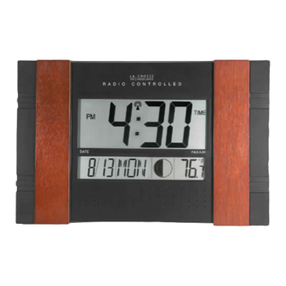
La Crosse Technology
La Crosse Technology WS-8001U instruction manual

KooKoo
KooKoo RedBarn manual

Velleman
Velleman WC8752 user manual

Oregon Scientific
Oregon Scientific Slim Projection Clock RA368P user manual
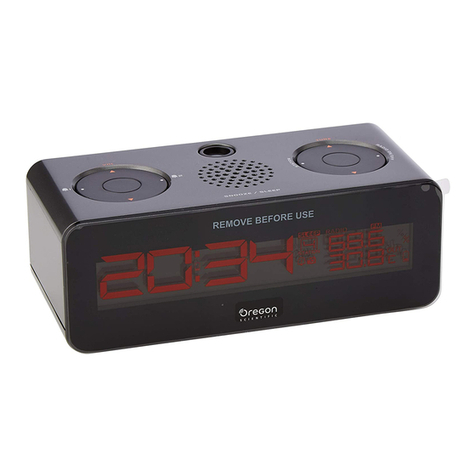
Oregon Scientific
Oregon Scientific RRA320PNX user manual
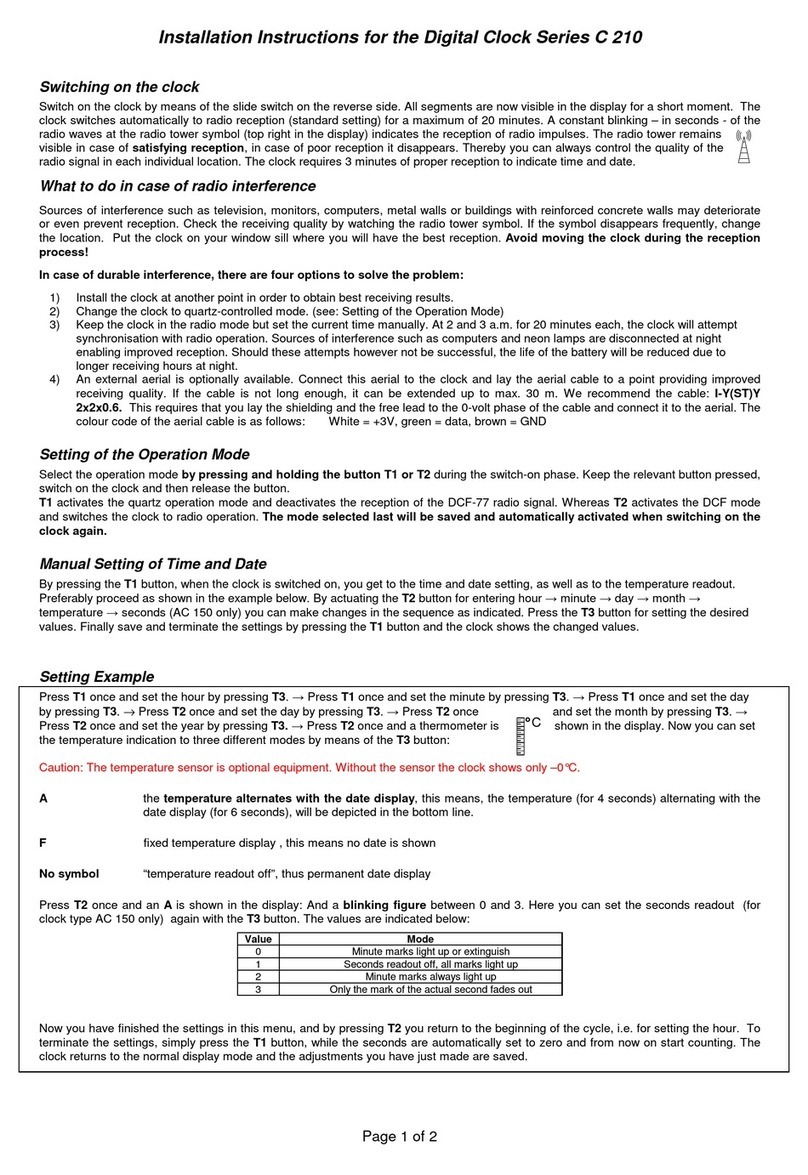
Valentin Elektronik
Valentin Elektronik C 210 Series installation instructions
